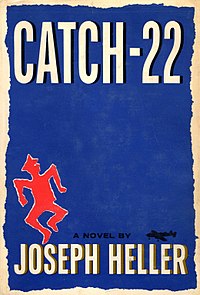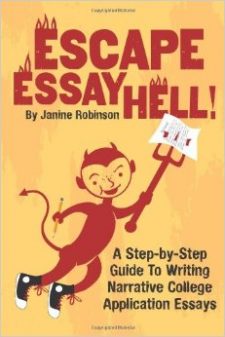by j9robinson | Oct 31, 2012

College Admissions Essays
Final Checklist
So you think you are done with your college admission essay or personal statement. Wait! You have worked so hard on that essay; it’s worth an extra few minutes to make sure it’s as good as you can make it. I know you are probably sick of it by now, so if you have time set it aside for a day or so. But before you send it out, give it at least one more critical read.
It’s fine if you don’t have all of these elements, but if you have some or most of them, chances are your essay will sing!
A grabber introduction. No? Try reading THIS POST and THIS POST to see if crafting an anecdote at the start will make it more compelling and memorable.
A twist. No? Try THIS POST to learn what these are and how to find them.
A universal truth or life lesson. No? There’s a good chance you already have one, but just didn’t recognize it yet. Read THIS POST to check yours.
A snappy title. No? My advice is to include a title if you can think of a clever one. Otherwise, just leave it out. Read THIS POST to help think of one.
Under word count. No? Read THIS POST to learn how to cut your essay and why it almost always helps.
DON’T PUSH THAT BUTTON YET!!
And make sure to read THIS POST on the steps to take to “fine edit” your college application essay and give it that winning polish!
I’m sure it’s perfect now! Good luck!
by j9robinson | Oct 8, 2012

College Admissions Essays
How to Give Them More Punch: FOCUS!
A common challenge in writing these college admissions essays is making sure they go deep enough. That doesn’t mean you have to talk about the meaning of life, and allude to Shakespeare, Greek myths and Kafka, and try to sound profound. It usually just means that you need to explore what you are writing about more thoroughly. Here’s my advice: If your writing is too general, and your points and ideas are spread out all over the place, chances are they are shallow in nature. Picture a pool of water. The more spread out and wide it is, the shallower it gets. If you shore it up and make it smaller in total width, it gets deeper.
So how do you shore up your ideas and points in your essays? The best way is to get specific–which is, the opposite of general. Simple, right? If you can focus your topic (and main point you are going to make in your essay) from the beginning, the easier it will be to develop depth in what you have to say about it. (Read more about the power of “mundane topics” HERE.) When brainstorming topic ideas, it’s okay to start with broad ideas, but make sure to drill down before you start writing.
Here’s an example. Just last week, I helped a student brainstorm ideas for his personal statement for the Common App. It went like this:
(more…)
by j9robinson | Dec 28, 2011

So you have a rough draft for one of your college essays.
You answered the prompt, read it many times and believe it’s a solid piece of writing.
And you may be right.
But even a solid essay can have one fatal flaw–-it’s boring.
The last thing you want is for the admissions person to toss your well-written essay in the “read later” pile. Here are a couple tips on how to bump it up:
1: Your introduction is the most important part of the essay, since it will either grab the reader or not.
Often, writers start by providing background on their topic and then get to the good stuff. Try to take out the first sentence, or two, and see if you can start farther into your story.
You might have to rewrite it a bit, but often you just don’t need that general background right at the beginning.
It’s best to switch it up and get right to your best example or point, and then provide the background later. If you can start with your most interesting examples or points, you will grab your reader all the faster, and that’s exactly what you want.
EXAMPLE: “When I was in high school, I played the violin in the school band. It was my favorite activity and I never missed a practice or performance. But one day, to my horror, I left my thousand-dollar violin on the school bus…”
You are building up to something exciting here. Try to start right at the heart of the action, the moment you left the violin and your reaction: “As I stepped off the bus, I had the vague feeling I was missing something.
But I was late for my orthodontist appointment, and ran to meet my friends. It was only later that night that it hit me: I left my thousand-dollar violin under the seat.” (And then you can go on to background your history playing the violin, etc.)
(more…)
by j9robinson | Sep 9, 2010
 It feels like a set-up. First, you are supposed to reveal how wonderful you are in 500 words–about the number you can cram onto a postcard in your teensiest handwriting. Second, you must sell yourself to the college of your dreams—setting yourself apart from the thousands of other equally wonderful students–but appear humble and likeable at the same time. Third, no one has ever taught you how to write this type of essay, called a personal narrative. No one. Ever!
It feels like a set-up. First, you are supposed to reveal how wonderful you are in 500 words–about the number you can cram onto a postcard in your teensiest handwriting. Second, you must sell yourself to the college of your dreams—setting yourself apart from the thousands of other equally wonderful students–but appear humble and likeable at the same time. Third, no one has ever taught you how to write this type of essay, called a personal narrative. No one. Ever!
I call this impossible challenge the Catch 22 of College Essays, at least the part about saying how great you are and staying meek at the same time. You know, make an impression but don’t dare try to impress anyone!! No wonder you are stressed out!!!
The best way to handle this challenge–and I have detailed how to do this all over my blog–is to stick with a story. And it doesn’t have to be a life-changing, mind-blowing event, either. In a weird way that I don’t quite understand, the less impressive the story—the more basic, simple, everyday, mundane it is—the better it will go over. (Learn more about the power of mundane topics.)
Here’s how it works: When you tell your story, you naturally show the reader about yourself. You can avoid that awkward tone of voice that sounds boastful when you describe yourself: I’m a really creative person. I’m really passionate. I’m really great at solving problems. For some reason, when you hear someone say something like that, your first reaction is to think, with great sarcasm, “Oh, you are, are you? Well, good for you!” Whereas, if you just describe the time you built a ten-foot sculpture out of driftwood, feathers, dryer lint and goat hair, the reader might think, without a hint of sarcasm, “Wow, that’s pretty cool. That girl sounds creative.” See the difference? More on Show, Don’t Tell.)
I know I’ve hammered on this, but find your anecdotes, your examples, interesting moments, and just describe what happened—and then examine what you learned from them. It’s hard to go wrong with a story.
Read this post on How to Write an Anecdote to get started telling your best stories!

by j9robinson | Jun 14, 2010

It’s time to let go of the 5-paragraph essay format that most English teachers have pounded into your DNA by now.
College admissions essays are very different from the formal academic essays you wrote in high school.
How?
Well, most are called “personal narratives,” which use the first-person to tell a story or explore a personal insight about yourself or something you value. The majority are written in a more casual style (tone, voice and structure).
Like the 5-paragraph essay, however, they still need to make a “main point,” and they require a structure, although one that is much looser.
Here is one simple technique that can give your essay a structural “spine,” yet keep it engaging and breezy in style.
It’s called Show and Tell (not to be confused with the writing axiom, “Show, don’t Tell.”)
It’s really a simplified version of another writing approach I outlined in an earlier post, called The Ladder of Abstraction.
This is how you do it:When you write, make sure to go back and forth between “showing” the reader your point to “telling” the reader what it means.
Write a Show paragraph, then write a Tell paragraph, then switch back to a Show paragraph, etc. (Most 5-paragraph essays start by Telling, whereas this approach starts with Showing.
When you Show, you are focused and specific, often by providing examples and supporting details.
* * *
When you Tell, you are broad and general, and explain the meaning.
* * *
How to SHOW:
- Be specific. (Instead of saying, “The dog was cute.” Say, “The dog, a miniature poodle named Jack, rolled over when you commanded him to ‘Speak!’”)
- Give details. Remember “concrete details”? That just means words that are specific. (Instead of saying, “The trip was awesome,” say “We dove for albacore, built a giant bonfire and road the zip-line ten times.”)
- Use your senses to describe: What do you see, hear, taste, smell and feel?
- Give examples. If you Tell about something, “Everyone was upset by the ruling,” Show them by giving examples of how upset they were, “First, women threw up their hands and screamed. Then, a couple children burst into tears. One man punched the wall.”
- Use anecdotes or “mini-stories” to put the reader in the middle of the action.
- Compare things to make your point. This is another way to Show more clearly what you mean. Instead of, “It was very hot outside.” Say, “It was as hot as a car roof in Arizona.” (Yes, the formal words for these are “similes,” “metaphors” and “analogies.”)
- Zoom in. Like a zoom lens, take a closer look at what you are talking about, show/describe the little things close up.
How to TELL:.
- Be broad and general.
- Explain what something means.
- Summarize a group of smaller ideas.
- Reflect on the larger meaning of something. Look for “universal truths.”
- Analyze what something means.
- Interpret something you wrote.
- Zoom out. Step back from your points and examine the Big Picture.
- When you Tell, you are usually providing “meaning. “What does that mean?”
When you read other students’ sample essays, see if you can spot when they are Showing and when they are Telling. It might make more sense. Then, give it a shot with your own essay.
Check out How to Write a College Application Essay in 3 Steps to get started on your college application essay!
Got questions? I LOVE comments!
by j9robinson | Aug 25, 2008

Some college counselors advise students to think of their life as a book and write down some chapter titles. Then pick one you like and expand upon it. This naturally directs the essay into a narrative (story-telling) delivery.
I thought of a few from my own background as examples:

“Chasing grizzlies in Wyoming”
“Playing cribbage with my new blind friend”
“Burning crepes at the Magic Pan”
“Working the graveyard shift at White Castle”
“How I became student body president–by accident”
“The day I spent in the New York bus station”
See what you come up with. You might be surprised that you have a bestseller! Click HERE for other posts to help you find the magic topic!















